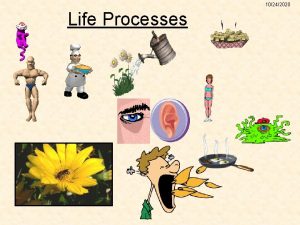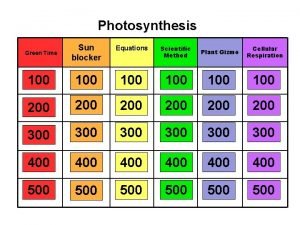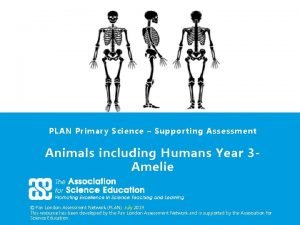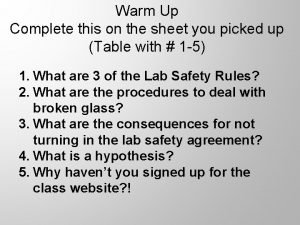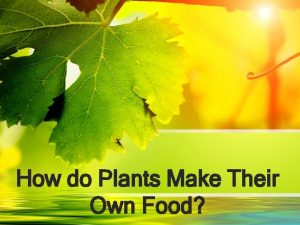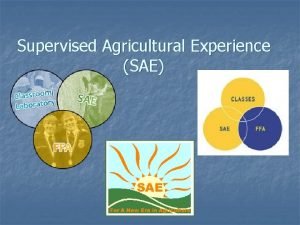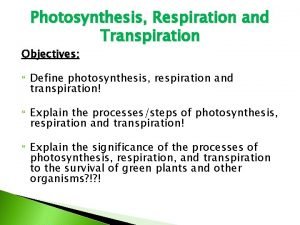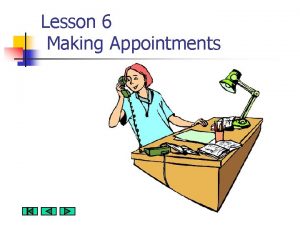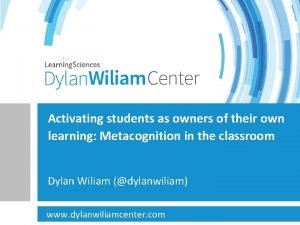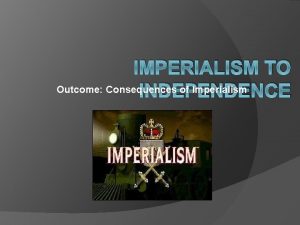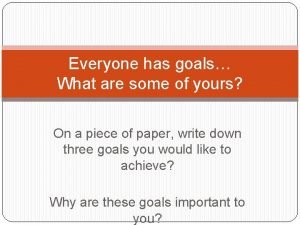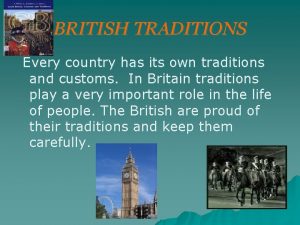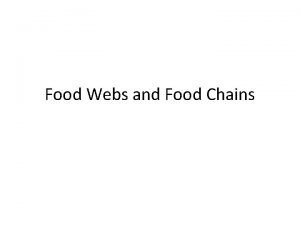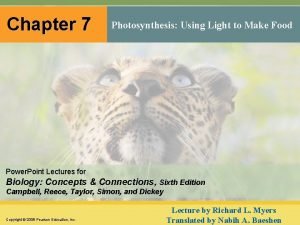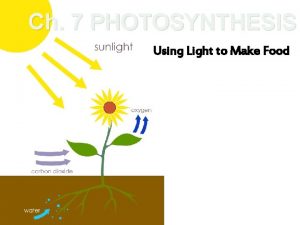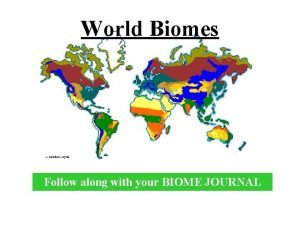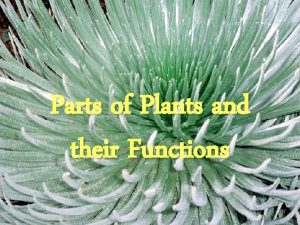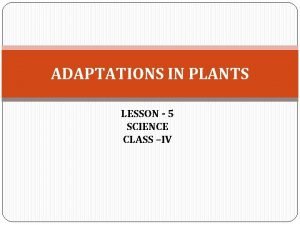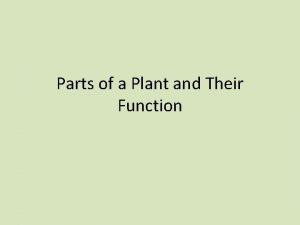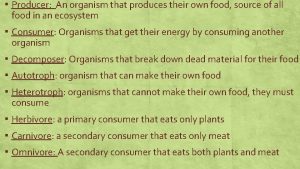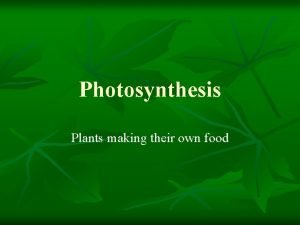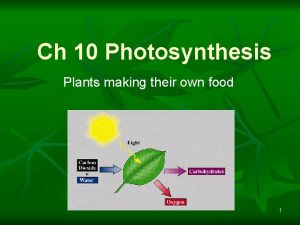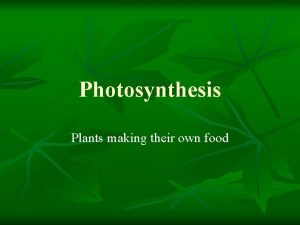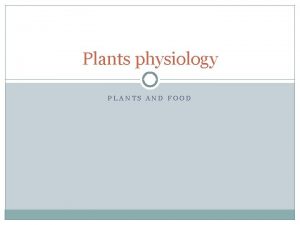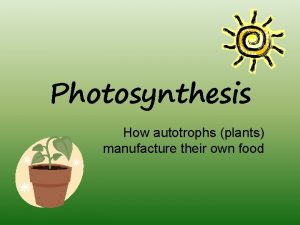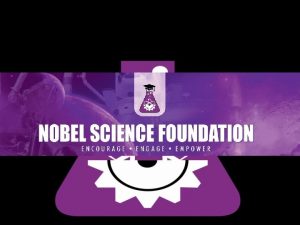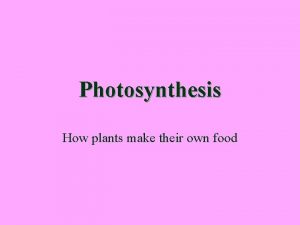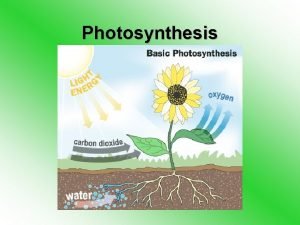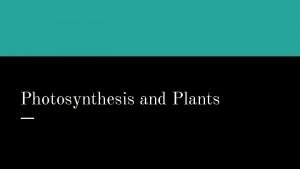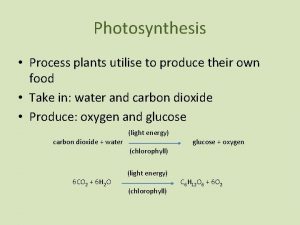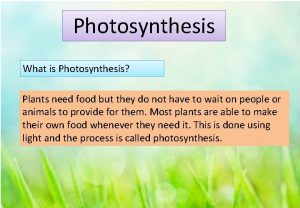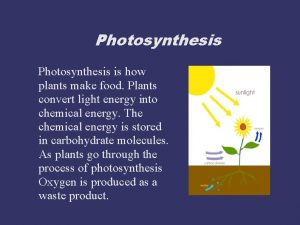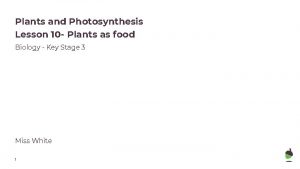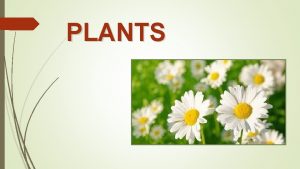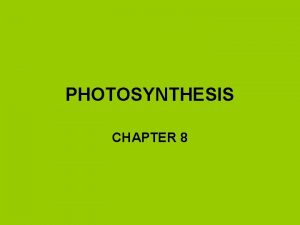Photosynthesis Plants making their own food How do


















![Table of results Distance [d] from light source (cm) Light Intensity or 1/ 2 Table of results Distance [d] from light source (cm) Light Intensity or 1/ 2](https://slidetodoc.com/presentation_image_h2/a5551d70953492464af059fbd899f285/image-19.jpg)













- Slides: 32

Photosynthesis Plants making their own food

How do plants grow? Plants actually grow by making their own food, not by eating soil!



Balanced Equation for Photosynthesis 6 CO 2 + 6 H 2 O + light +Chlorophyll C 6 H 12 O 6 + 6 O 2

Sources of light for plants • Sunlight is the natural source of light for plants • plants can use artificial light for photosynthesis and this is often used in greenhouses stimulate growth

Chlorophyll chlorophyll The green pigment chlorophyll is found in chloroplasts.

Sources of carbon dioxide • From the atmosphere through stoma in their leaves • From their own cellular respiration • Artificial sources of carbon dioxide eg. burning gas in a green house

Sources of water for plants • Water is absorbed from the soil by the roots of plants • This water passes up the stem via xylem cells

By the end of today’s class you should be able to: • Explain the main events in photosynthesis

The main stages in Photosynthesis Light is absorbed Water is split Products are produced (4 protons, 4 electrons and oxygen) • Light energises electrons • Glucose is formed • • •

1. Light is Absorbed • Energy from the sun is absorbed by chlorophyll in chloroplasts.

2. Water is Split • The trapped light energy is used to split water into oxygen gas (O 2) protons (H+) and electrons (e-) • Summarised as 2 H 2 O 4 H+ and 4 e- and O 2

3. The products of water splitting seperate • The electrons are passed to chlorophyll n n The protons are stored in a proton pool for later use The oxygen may pass out of the leaf into the atmosphere or else may be used for plant respiration

Light Energises Electrons • The electrons that were passed to the chlorophyll gain light energy and this changes them into high energy electrons

Glucose is formed • The high energy electrons along with protons from the proton pool are combined with carbon dioxide to form glucose (C 6 H 12 O 6 )

Learning Check • • What are the main stages in photosynthesis? What is water split into? What happens to each of these products? What is the trapped light energy used for?

Investigate the effect of light intensity on the rate of photosynthesis. Mandatory experiment • Investigating the effect of the • For light source at 100 cm away from Elodea: Allow 5 minutes for plant to stabilise, then count air bubbles in one minute, Repeat for 2 different minutes to get the average. • Repeat for plant at 80 cm, 60 cm, 40 cm, 20 cm, from plant.
![Table of results Distance d from light source cm Light Intensity or 1 2 Table of results Distance [d] from light source (cm) Light Intensity or 1/ 2](https://slidetodoc.com/presentation_image_h2/a5551d70953492464af059fbd899f285/image-19.jpg)
Table of results Distance [d] from light source (cm) Light Intensity or 1/ 2 d (No. of bubbles/ minute) Average Trial 1 Trial 2 Trial 3

Graph of results • With increasing light intensity photosynthesis will increase up to a point where photosynthesis will not increase any more (called the saturation point) • It does not increase any further as there is something else which the plant needs – maybe more Carbon dioxide or water!!

Photosynthesis Extended Study (Higher Level only)

Light Stage (HL) • It involves the very fast movement of electrons and is not controlled by enzymes • Light is absorbed by pigment molecules, which pass light to the chlorophyll (almost all colours of light are absorbed but green is normally reflected)

Light Stage (HL) • Chlorophyll absorbs as much light energy as possible and passes which it passes to an electron • The energised electron is passed to the electron acceptor which can the send it on one of two pathways

Electron Flow Pathway 1 (HL) • In pathway 1 the electrons pass from the first electron acceptor to a series of other electron acceptors and back again to the chlorophyll • As the electrons are passed around they lose energy • This energy is used to join a phosphate to ADP to form high energy ATP (Water is also formed in this process)

Electron Pathway 1 (HL) • ADP + Energy + P ATP + Water • The addition of phosphate to ADP is called phosphorylation • Because the electron travel in a cycle and returns to its original chlorophyll this process is called Cyclic Electron Transport or Cyclic Electron Phosphorylation

Electron Pathway 2 (HL) • 2 high energy electrons are passed from chlorophyll to the electron acceptor • In this case the electrons do not return to the original chlorophyll • Eventually the 2 electrons are passed to combine with NADP+ to form NADP-

Electron Pathway 2 (HL) • The splitting of water happens (Photolysis) • The electrons pass along electron tranport chain and release energy, which is used to make ATP • Oxygen is released from the plant or used in respiration • The protons that were stored in the proton pool are attracted to NADP- and combine with it to form NADPH • Known as Non cyclic electron transport

End Products of the Light Stage (HL) • There are 3 end products of the light stage 1. ATP this will provide energy for the dark stage 2. NADPH this will provide protons + energised electrons for the dark stage 3. Oxygen is made when water is split

Dark Stage (HL) • This may also be called the light independent stage as it can occur in the light but does not need to use it • It is controlled by enzymes and therefore can be affected by temperature

Dark Stage (HL) • Carbon dioxide from the air enters the chloroplast where they combine with protons + electrons to form glucose • This needs energy and protons + electrons

Dark Stage (HL) • It uses energy got from breaking down ATP into ADP + P • It uses hydrogen ions and electrons got from breaking down NADPH into NADP+ + 2 electrons + H+

Dark Stage • ADP + P and also NADP+ return to the light phase where they an be reused.
 What is the word equation of photosynthesis
What is the word equation of photosynthesis Green plants make their own food by photosynthesis
Green plants make their own food by photosynthesis Life processes of living things
Life processes of living things The food that plants produce during photosynthesis is
The food that plants produce during photosynthesis is Animals can make their own food
Animals can make their own food Animals can make their own food
Animals can make their own food Organisms that make their own food
Organisms that make their own food Chloroplast function
Chloroplast function What type of sae is when you own your own business
What type of sae is when you own your own business Photosynthesis define
Photosynthesis define Making new words your own lesson 20
Making new words your own lesson 20 Making new words your own lesson 2
Making new words your own lesson 2 Nonvascular plant
Nonvascular plant Vascular vs nonvascular plants
Vascular vs nonvascular plants Non flowering plants characteristics
Non flowering plants characteristics C3 plants vs c4 plants
C3 plants vs c4 plants Unit 2 food food food
Unit 2 food food food Eltonian pyramid
Eltonian pyramid Activating students as owners of their own learning
Activating students as owners of their own learning Why did gandhi encourage indians to weave their own cloth?
Why did gandhi encourage indians to weave their own cloth? Everyone has their own goals
Everyone has their own goals Every country has its own traditions
Every country has its own traditions Food chain photosynthesis
Food chain photosynthesis Chapter 7 photosynthesis using light to make food
Chapter 7 photosynthesis using light to make food Photosynthesis using light to make food
Photosynthesis using light to make food Plant adaptations temperate forest
Plant adaptations temperate forest Plants parts and function
Plants parts and function Plants and their functions
Plants and their functions Adaptation in plants
Adaptation in plants What are the 4 parts of a plant
What are the 4 parts of a plant What is inferring
What is inferring War making and state making as organized crime summary
War making and state making as organized crime summary An organism that makes its own food *
An organism that makes its own food *


